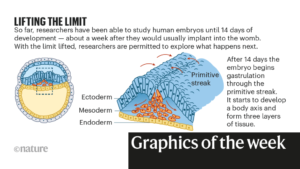Measuring the density structure of an accretion hot spot – Nature
Observations and knowledge discount
Our marketing campaign of GM Aur was undertaken principally throughout 2019 December. Here we current knowledge spanning the X-ray to the optical from Swift, HST, LCOGT, TESS and CHIRON. We present particulars on the knowledge discount under.
Swift observations have been taken with the X-ray Telescope30 and the Ultraviolet and Optical Telescope31, utilizing the UVM2 filter (2,221 Å), day by day between 2019 November 27 and 2019 December 27, besides on days when observations couldn’t be scheduled. For the 27 observations, remark IDs, publicity occasions, begin occasions, X-ray rely charges, NUV fluxes and measurement uncertainties are listed in Extended Data Table 1. The remark IDs are as follows: 0034249045–0034249058, 0034249060–0034249063, 0034249065–0034249070 and 0034249072–0034249074. We used the High Energy Astrophysics Science Archive Research Center (HEASARC) HEASoft software program (model 6.22.1) to measure rely charges and NUV fluxes. X-ray emission from the stellar corona is thought to be variable32,33. X-ray rely charges (0.5–10.0 keV) of GM Aur normally diverse between 0.006 counts s−1 and 0.029 counts s−1 (Extended Data Fig. 1) and are akin to these beforehand seen in GM Aur34, pointing to an X-ray luminosity of round 3 × 1030 erg s−1 (assuming a distance of round 160 computer35) all through the marketing campaign. The rely price was highest on 2019 November 27 (0.046 counts s−1). None of the X-ray variability noticed appears to correlate with another knowledge obtained throughout this marketing campaign (Fig. 1, Extended Data Fig. 1) and so we don’t talk about it additional.
HST NUV–close to-infrared (NIR) spectra (1,700–10,000 Å with a decision, R, of 500–1,000) have been taken with the Space Telescope Imaging Spectrograph (STIS) on 2019 December 6, 7, 8, 9 and 10 (Extended Data Fig. 2) in programme 16010. The spectra have been obtained with the G230L, G430L and G750L gratings, with a 52″ × 2″ slit, inside one orbit per go to. Data have been lowered mechanically by the HST pipeline; we appropriate fringing in the G750L knowledge36. Archival G230L and G430L spectra of the non-accreting star RECX 1 (programme 11616) have been used as the template for the accretion-shock modelling evaluation under. Typical uncertainties on the HST spectra are 3%–15%.
TESS knowledge have been taken on 2019 November 28 to 2019 December 23 (sector 19), with a cadence of 2 min (Fig. 1). The TESS bandpass covers 6,000–10,000 Å and is centred at 7,865 Å. Data have been lowered utilizing the Science Processing Operations Center pipeline. We used Lightkurve37 to verify the knowledge high quality and located little contamination from close by sources. The hole in the knowledge is because of knowledge obtain throughout orbital perigee. Typical uncertainties in the TESS knowledge are 0.25%.
(adsbygoogle = window.adsbygoogle || []).push({});
u′g′r′i′ knowledge have been taken roughly 5–10 occasions on clear nights at the LCOGT38, with the Sinistro Imagers on the 1-m telescopes, between 2019 November 26 and 2020 January 1. The u′g′r′i′ filters have central wavelengths of 3,540 Å, 4,770 Å, 6,215 Å and seven,545 Å, and wavelength widths of 570 Å, 1,500 Å, 1,390 Å and 1,290 Å. Data in Fig. 1 have been lowered utilizing the Aperture Photometry Tool and commonplace aperture photometry methods. Uncertainties in all bands are lower than 0.005 magazine. The flux of GM Aur was calibrated utilizing the fluxes of background objects, which in flip have been flux-calibrated utilizing UBVRI knowledge of background objects (transformed to u′g′r′i′39) and the GD 64 commonplace discipline40. These calibration knowledge have been taken contemporaneously at the 4.3-m Lowell Discovery Telescope (LDT), utilizing the Large Monolithic Imager, on 2019 December 2, 7, 10, 13, 18 and 21. The LDT knowledge are used right here solely to flux-calibrate the LCOGT knowledge.
Medium-resolution (R ≈ 25,000) optical (4,082–8,906 Å) spectra have been obtained with CHIRON41, on a 1.5-m telescope that’s half of the Small and Moderate Aperture Research Telescope System (SMARTS) at Cerro Tololo Inter-American Observatory, between 2019 November 28 and December 17 (Extended Data Fig. 3). The commonplace CHIRON pipeline just isn’t optimized to extract the Hα profile of younger stars; we cut back the spectra right here42.
Timing evaluation
Although the periodicity and time lag in the gentle curves are evident (Fig. 1), right here we measure the interval of the TESS and LCOGT u′g′r′i′ gentle curves in addition to the time lag between the peak in the u′ gentle curve and people in the g′r′i′ and TESS gentle curves.
The Swift NUV knowledge are a lot sparser, and we don’t analyse them in as a lot element.
To measure the interval in the gentle curves, we use the Astropy Lomb–Scargle periodogram operate43,44,45. We receive a 5.8-day interval for the TESS gentle curve; for the u′g′r′i′ gentle curves, we measure intervals of 6.3, 6.3, 6.Three and 6.1 days. The Swift NUV flux is bigger than 50% increased than surrounding days on November 30–December 1, December 7–Eight and December 19 (Fig. ), which is in step with a roughly 6-day interval. Given that the independently measured rotation interval of the star is 6.1 days21, we attribute the roughly 6-day interval measured in the gentle curves to stellar rotation.
For the time-lag evaluation, we use the Python package deal Stingray46. When in comparison with the u′ gentle curve, we measure time lags of round 0, 0.75, 1.1 and 1 days for the g′r′i′ and TESS gentle curves. The Swift NUV flux is highest on the similar days as the peaks seen in the u′ gentle curve (Fig. 1). We conclude that the time lag between the UV and optical knowledge is about 1 day.
Accretion-shock modelling
To additional discover the roughly 1-day time lag in the peak between the UV and optical knowledge seen in Fig. 1, we deal with 2019 December 6–10 (Fig. 2a, b) as a result of HST knowledge have been taken day by day throughout this time. HST NUV spectra are the greatest measure of accretion as a result of the accretion column that channels materials onto the floor of the star emits substantial power at NUV wavelengths1.
The HST knowledge have been fitted utilizing accretion-shock fashions22. These fashions present data on the bodily properties of the accretion column and the related hot spot, which is the footprint of the accretion column on the stellar floor. The accretion column is characterised by an power flux (ρvs3/2), which measures the density of materials in the accretion column (ρ), assuming that the magnetospheric radius (Rmagazine) and infall velocity (vs; right here 456 km s−1, which is dependent upon the stellar radius Rstar, stellar mass Mstar and Rmagazine) are fixed. Each column has a filling issue f, which provides the fraction of the stellar floor lined by the column (that’s, the hot spot).
GM Aur is a effectively studied supply in the NUV, with eight beforehand modelled epochs18. In Fig. 2c–f, we plot the accretion-column mannequin parameters (Extended Data Table 2) obtained from becoming the HST knowledge (Extended Data Fig. 2). The becoming was achieved with three accretion columns7,18, with power fluxes of 1 × 1010 erg s−1 cm−2, 1 × 1011 erg s−1 cm−2 and 1 × 1012 erg s−1 cm−2, and adopting printed stellar parameters47. Here we seek advice from the 1 × 1010 erg s−1 cm−2 and 1 × 1012 erg s−1 cm−2 elements as the ‘low-density’ and ‘high-density’ areas. The complete power flux (Fcomplete; Fig. 2c) is the sum of the power fluxes of all the areas, weighted by their respective f. The complete hot-spot protection on the stellar floor (Fig. 2e) is the sum of the f values for all the areas.
The complete power flux peaks together with the UV knowledge (Fig. 2c). When the power flux peaks on December 7, it’s dominated by emission from a high-density area, which then drops considerably (Fig. 2d). This means that on December 7 we see the high-density area of the hot spot and that in the following three days most of this high-density area is not seen. Meanwhile, the hot-spot protection of the star peaked about 1 day later, on December 8, together with the optical knowledge (Fig. 2e), and the hot spot is dominated by emission from a low-density area (Fig. 2f). Because the low-density area of the accretion column emits its power at longer wavelengths7, it follows that the optical emission peaks when the hot spot is at its largest. The noticed behaviour in the gentle curves could also be interpreted by combining two results: the stellar rotation and the completely different bodily areas for the high-density and low-density areas. It then follows that the high-density area of the hot spot (whose power seems primarily in the UV) will result in a peak in the UV knowledge when the high-density elements of the hot spot are seen to the observer. As the star rotates, we could also be seeing a denser half of the hot spot first, which then rotates out of view.
Accretion-flow modelling
To facilitate comparability to the three-dimensional (3D) magnetohydrodynamic (MHD) simulations, we have to estimate the magnetospheric radius of GM Aur. Magnetospheric accretion-flow modelling48,49,50 of the Hα line offers properties of the accretion move. The mannequin assumes that the magnetic, stellar-rotation and disk-rotation axes are aligned. The materials flows onto the star alongside an axisymmetric accretion move that arises from the co-rotating fuel disk. The geometry of the move is described by a dipolar magnetic discipline and characterised by an internal radius (Ri, which corresponds to Rmagazine) and the width of the move (Wr) at the disk airplane. The mannequin assumes a gradual-move prescription for a given accretion price to find out the density at a given level. The temperature at every level is decided parametrically, scaled to the density assuming a continuing heating price in the move; the most temperature in the move (Tmax) describes every mannequin. To calculate the emission line profile, the mannequin assumes the prolonged Sobolev approximation and calculates the imply depth and the stage inhabitants of a 16-level hydrogen atom, and makes use of the ray-by-ray methodology for a given viewing inclination (i).
We created a big grid of fashions various the accretion price, Rmagazine, Wr, Tmax and i, utilizing the ranges of parameters acceptable for accreting T Tauri stars49. With these mixtures, we calculated round 72,000 mannequin profiles. We convolved the mannequin profiles with a Gaussian instrumental profile of CHIRON’s decision and fitted every noticed profile inside ±400 km s−1 from the line centre. The most closely fits are decided by calculating the χ2 for every mixture of the mannequin and noticed profile.
For every noticed profile, we chosen 100 most closely fits and calculated the means of the accretion price, Rmagazine, Wr, Tmax and i (Extended Data Table 3). The accretion charges listed in Extended Data Table 3 are increased on the dates for which there are peaks in the UV emission. The derived i are roughly in step with the measured inclination of the disk, which is 53°17. Wr varies between 0.2Rstar and 0.5Rstar; Tmax varies between 8,270 Okay and 9,120 Okay. We use the derived Rmagazine of GM Aur to match it to simulations in the subsequent part.
In Extended Data Fig. 3, we present the greatest-becoming mannequin to the Hα profiles. The match to the line wings is excellent. The areas with robust absorption options on the blue aspect of the line have been excluded from the match; this blueshifted absorption might be from winds, which aren’t included in the mannequin. There isn’t any periodic sample in the Hα line (Extended Data Fig. 3). However, multicomponent excessive-velocity blueshifted absorption, beginning on December 7, happens together with peaks in the UV emission (Fig. 1) and accretion price (Extended Data Tables 2, 3). There is a doable second element at increased, blueshifted velocity on December 6, which could suggest a deceleration after the launching of a higher-density outflow occasion that will presage the accretion occasion on December 7. Models51 present that there’s a disk-wind element to the Hα profile, which manifests as blueshifted absorption; this element is dominated by the innermost disk, inside tens of stellar radii.
3D MHD simulations of accretion
Here we present world 3D MHD simulations of a rotating magnetized star accreting from a disk5,23,25. In transient, the fashions assume that the star has a dipole magnetic discipline with a misalignment angle (θ) between the rotation axis (Ω) and magnetic axis (μ). The rotation axes of the star and disk are aligned. Here we use simulations with the similar arrange as earlier work23,25, with parameters chosen to approximate the properties of GM Aur.
We assume that the magnetic discipline of GM Aur could be approximated with a dipole discipline. The hot spot of GM Aur is at a excessive latitude of about 77°, measured from radial velocity variations of He i (5,876 Å)52; earlier work additionally discovered that the hot spot is at excessive latitudes for dipole–octupole configurations1. Also, GM Aur has a protracted rotation interval21, and younger stars with less complicated, extra dipole magnetic fields are slower rotators53. Simulations23 present that the properties of the hot spot depend upon θ, the corotation radius (Rco) and Rmagazine. For GM Aur, θ = 13°52. This is in step with the vary of inclinations of the accretion move inferred from modelling the Hα profile (all the greatest-becoming inclinations in Extended Data Table 3 are inside about 10° of the system inclination of 53°). Using a stellar rotation interval of 6.1 days21, Rstar = 2Rsolar and Mstar = 1.36Msolar47 (the place Rsolar and Msolar are the radius and mass of the Sun), Rco = 7.8Rstar (0.07 au). We measure a imply Rmagazine of about 3.8Rstar, with a spread of 3.4Rstar to 4.6Rstar (Extended Data Table 3). The simulations use θ = 20°, Rmagazine ≈ 4.5Rstar and Rco = 5.7Rstar, that are in step with the parameters of GM Aur.
The 3D MHD simulations have an approximate accretion price of about 1.1 × 10−8Msolar yr−1, which agrees with measurements from the accretion-shock and accretion-flow modelling (Extended Data Tables 2, ). The power distribution in the spots in the 3D MHD simulations varies between about 3.9 × 109 erg s−1 cm−2 and 1.2 × 1011 erg s−1 cm−2; that is in step with the accretion-shock fashions, which use power fluxes of 1 × 1010 erg s−1 cm−2 to 1 × 1012 erg s−1 cm−2. The densities of the 3D MHD simulated spots in Fig. 4 vary between about 5.5 × 10−13 g cm−3 and 5.97 × 10−12 g cm−3, which overlaps with the accretion-shock fashions, the place the densities are 2.1 × 10−13 g cm−3 to 2.1 × 10−11 g cm−3. The simulated gentle curves peak at a luminosity of about 1 × 1031 erg s−1 (Fig. 4), which is roughly in step with the accretion luminosities of about 0.1Lsolar to 0.2Lsolar (3.8 × 1032 erg s−1 to 7.7 × 1032 erg s−1; Lsolar is the luminosity of the Sun) measured from the HST spectra. In Fig. 4 we present the gentle curve solely as soon as accretion onto the star begins in the simulation. To generate the gentle curve for the densest area of the hot spot, we use ρ > 6.5 × 10−12 g cm−3.
A ratio of Rco/Rmagazine = 1.5 units the boundary between secure and unstable accretion25. In the secure regime, matter accretes onto the star in ordered funnel streams, and symmetric, crescent-formed hot spots are anticipated54. In the unstable regime, matter accretes in chaotic hot spots25. The simulations have Rco/Rmagazine = 1.3–1.4. The measured Rmagazine of GM Aur has an uncertainty of about 1Rstar, so Rco/Rmagazine for GM Aur might attain 1.4. Therefore, the simulations are in step with the properties of GM Aur, and each are close to the boundary of the secure–unstable regime. Here, processes at the disk and magnetosphere boundary might trigger the behaviour seen in the noticed gentle curves. The internal disk rotates extra quickly than the magnetosphere, resulting in non-stationary behaviour of matter in the internal disk and corresponding non-stationary behaviour of the hot spot. The hot spots are predominantly crescent-formed, however might turn out to be uneven (Fig. 4). Also ensuing from the distinction in the disk and magnetosphere rotation, the non-stationarity results in variation of the density distribution in the hot spot that particularly influences the densest elements of the spot, which can sometimes disappear. This might clarify why the UV emission (related to the high-density area of the hot spot) disappears in Fig. 1.



